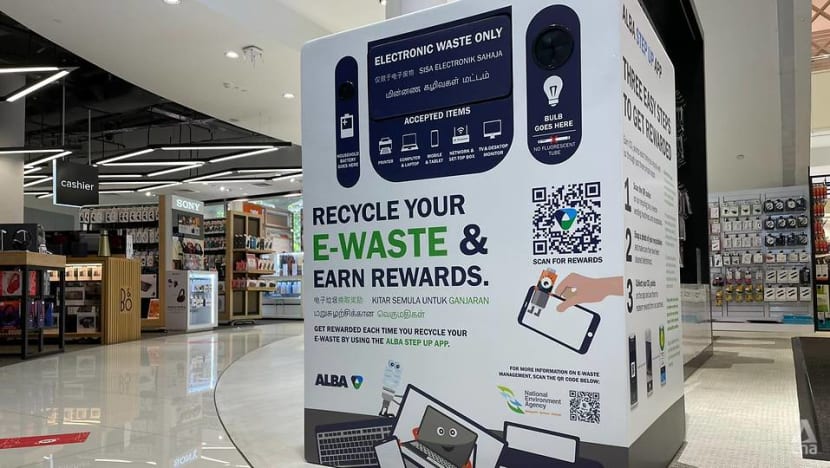Commentary: E-waste bins now a common sight, but can we be counted on to use them properly?
If our old phones and laptops could be magicked away so easily, we won’t see the costs and labour that go into treating them safely. This Earth Day, it’s worth looking at what’s being done to address our e-waste problem, says CNA’s Erin Low.

A three-in-one e-waste recycling bin at a Harvey Norman outlet that can take in ICT equipment, light bulbs, and batteries. (Photo: Vanessa Lim)
SINGAPORE: While heading to work, I spotted an electronic waste bin tucked in a corner. How convenient, I thought, that I could recycle e-waste on my way to the office instead of trekking to a drop-off point somewhere else.
Amassing broken earbuds, fraying USB cables and old phone chargers at home, I vowed to recycle them when I went to the office again.
But when that time came, I found the bin filled with tissue wads and random bits of rubbish.
It was a massive face-palm moment. How could anyone miss the giant “E-WASTE” sticker?
It’s something worth dwelling on this Earth Day. Singapore businesses and government agencies alike are going big on recycling, with e-waste identified as a priority waste stream.
It has never been easier to recycle our e-waste. Singapore has deployed more than 500 e-waste recycling bins in public places like town centres, shopping malls and community centres.
The National Environment Agency also launched the Extended Producer Responsibility (EPR) scheme in July 2021, which requires producers to manage the collection and treatment of electronics sold to Singapore consumers. For instance, retailers have to provide in-store e-waste collection points and offer to take back unwanted household appliances upon the delivery of a new one.

Recycling e-waste is one step towards the circular economy – taking junk we don’t want and salvaging its valuable parts for making new products, with less need for extracting fresh resources from the environment.
Laptops can be scrapped for copper, while circuit boards can be melted down to recover precious metals like gold.
But does making e-waste recycling too easy enable mindless consumption? If we could magic our e-waste away without seeing the costs and labour that go into treating them safely, would we confront the staggering amount of e-waste that we make in the first place?
A STAGGERING AMOUNT OF E-WASTE
Singapore generates 60,000 tonnes of e-waste annually, which adds up to about 70 mobile phones per person. Around 3,500 tonnes of consumer e-waste have been collected under the EPR scheme so far.
A 2019 study by NTU students found that only one in 10 young Singaporeans recycles e-waste. One-third of them do it wrongly by throwing it into general recycling bins.
And of what does end up in an e-waste bin, about 30 per cent isn’t regulated e-waste. Anything outside ICT equipment, light bulbs and batteries shouldn’t be put in the bin.
Misplaced junk could end up at Singapore’s Semakau landfill, which is due to run out of space by 2035. Proper recycling is crucial to slash the volume of waste that gets incinerated and disposed there.
Incinerated e-waste also has its hazards. Heavy metals and mercury can seep into our soil and pollute water. They contaminate ash at the landfill, so it cannot be reused for construction materials in the future.
Besides recycling, repairing electronics is the other solution to reducing e-waste. After all, many of us don't part so easily with our unwanted gadgets – the NTU survey found that 64 per cent of respondents hoard their old mobile phones and laptops.
But getting electronics repaired today is a tall order, with brands making their products easily outdated and less durable.
Through a combination of planned obsolescence and sleek marketing, consumers are nudged towards replacing their devices once they show signs of age and buying entirely new accessories to go along with them.
Consider how Apple’s new iPhones no longer come with headphone jacks or USB-C chargers. While the tech giant says that it’s a sustainable move to avoid giving customers new add-ons, more cynical observers see it as a cash grab where customers can only use AirPods and Lightning cables instead of generic accessories which they might already own.
THE COST AND LABOUR OF RECYCLING E-WASTE
Because the problem of e-waste is embedded in our relentlessly consumerist culture, recycling isn’t a silver bullet.
For one, recycling e-waste is high-effort but low-yield. At e-waste processing facilities, much manual labour is needed to sort and dismantle electronics, but one tonne of e-waste might only contain 200g of gold.
The ubiquity of e-waste drop-off points could make us victims of convenience. Once we dump it, it’s out of sight and out of mind, and we won't grasp how much e-waste we make and how challenging it is to process it.
This point is pertinent given the broader context of Singapore’s recycling statistics. In 2021, Singapore recycled 55 per cent of overall waste, a rate higher than 52 per cent in 2020, but lower than 59 per cent in 2019. Households recycled 13 per cent of waste, a figure unchanged from last year and lower than the 22 per cent in 2018.
It’s striking that these figures remain stubbornly low despite so many policies, national initiatives and campaigns.
Moreover, we produced 18 per cent more waste in 2021 as economic activities resumed, making the issue of cutting down the waste which we generate in the first place, rather than just recycling it, more pressing.
Is zero waste impractical in a wired, wealthy city where no one has time to repair faulty devices? Listen to CNA's Heart of the Matter:
TAKING RESPONSIBILITY FOR STUFF WE DON’T WANT
When it comes to cutting down on e-waste, the most obvious solution is to resist buying new gadgets we don’t need.
But that’s rich to say when e-commerce platforms push ad after ad about monthly sale bonanzas. Or when nobody will repair your decades-old television and refrigerator – or at a price so exorbitant that you might as well buy a new one.
Singapore’s efforts to get producers to take charge of their customers' e-waste are a step in the right direction.
Brands too are cluing in. In March, HP launched a subscription programme for printer ink cartridges in Singapore, which allows customers to return used cartridges for recycling while cutting printing costs by half.
This is a win-win situation because new printer ink cartridges can be so expensive that buying a brand new, cheap printer would be more cost-effective.
Seeing the business case in salvaging e-waste, Apple said in 2016 that it was developing a robot, named Liam, to recycle its products. While it’s unclear how much Liam has recycled since, the US government is funding research into robots that can identify different smartphones, remove batteries and harvest valuable parts.
With the wide variation of electronics out there, it might be a tall order to expect artificial intelligence sophisticated enough to take apart every product ever designed.
This is why moves to standardise certain parts – like the European Union’s plans to mandate USB-C charging ports for device makers – are sorely needed across the industry.
But these solutions are in their early days. And while some of us are counting on trash robots to power our circular economy, perhaps we can do the bare minimum: Read the labels on an e-waste bin properly and avoid putting stuff in there that doesn’t belong.
Erin Low is a research writer at CNA Digital.



















